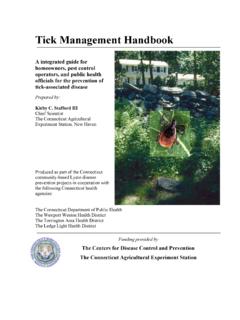Transcription of How to Order: Scioto Soil and Water
1 How to Order: Orders will be taken until Wednesday, February 21, 2018. Tentative order distribution date is the last Friday in March. Please plan for pick-up on this date. A postcard or email will be sent to confirm exact pick up date, location, and time. Be sure to include the number of packets ordered and your correct address and telephone number on the order form. Please complete the enclosed order form and mail it with your payment to: You may also place orders by stopping in our office between the hours of 7:30 and 4:00 , Monday through Friday. If you have any questions, please call 740-259-9231 ext. 4 For additional order forms or for additional details visit The Scioto Soil and Water Conservation District reserves the right to substitute species in the Specialty Tree Packets, Erosion Control Seed Mix, Wildlife Food Plot Seed Mix and Pollinator Seed Mixes based upon availability. NOTE: The Hard Mast Packet and Moist Soils Packet contains four (4) of each of the five species listed in the brochure.
2 There are a total of twenty (20) seedlings per packet. The Pollinator Packet contains two (2) of each of the five species listed in the brochure. There are a total of ten (10) seedlings per packet. SEEDLING SIZE: Tree and shrub seedlings should be between 6 and 18 inches tall, depending on the species. Seedlings should be planted within 5 days after pick-up and then watered regularly. Scioto SWCD 12167A State Route 104 Lucasville OH 45648 Scioto Soil and Water Conserva on District Scioto SWCD 12167A State Route 104 Lucasville OH 45648 740-259-9231 ext. 4 Order Deadline February 21, 2018 Deciduous Trees Black Cherry (Prunus serotina) Commercially important tree growing to 60+ ft. at maturity; commonly used for lumber, veneer, and furniture. Leaves are dark green in summer and yellowish in fall. The small black fruit provides food for a variety of birds and mammals. Tolerates a wide variety of growing conditions.
3 Black Walnut (Juglans nigra) A rapidly growing tree common in all of Ohio, is most common in moist bottomlands and open fields, but is found everywhere due to squirrels burying its nuts. It has dark green compound leaves and produces delicious nuts that are preferred by wildlife. It is valued for timber, veneer, and furniture. Grows well in most locations, but prefers fertile, deep soils. Mature height and spread is 70 ft. Prefers full to part sun. Northern Red Oak (Quercus rubra) Tall, relatively fast growing tree that can reach 80+ ft. at maturity. Leaves are shiny green in summer and bright red in fall. Makes an excellent tree for street or yard. Prefers full sun and acidic soil. It has a commercial value for furniture and lumber. Yields acorns that are round and 1inch long with a flat, thick, saucer-like cap. Acorns from this tree are at the top of the food preference list for blue jays, wild turkeys, squirrels, small rodents, whitetail deer, raccoons and black bears.
4 Deer also browse the buds and twigs in wintertime. Sugar Maple (Acer saccharum) This large shade tree, which can reach heights over 100 ft., is the cornerstone of the maple syrup industry. The medium green leaves can turn brilliant yellow, orange, or red in the fall. Prefers partial to full sun and well-drained soil. Excellent shade tree. White Oak (Quercus alba) A large, broadleaf tree growing to 100+ ft. at maturity. This species is shade tolerant, found on a variety of sites, and grows best in deep, sandy loam soil on south and west facing slopes. A great species for wildlife. Yields acorns that are up to 1 inch long with a warty cap that covers about of the nut. The acorns are one of the best sources of food for wildlife and are gathered, hoarded and eaten by birds, hoofed browsers and rodents. Leaf buds also are eaten by several bird species, and all parts of the tree are a favorite food for deer. 2018 Tree pick up will be Friday only - Please plan accordingly.
5 2 11 Care on Arrival Tree seedlings require Water and cool temperatures to survive until planted. If you intend to plant the trees within a week (recommended), keep them in the shipping package in a cool or shaded location, such as a cooler (above freezing), basement, outbuilding, or on the north side of a building. If planting will be delayed longer than a week, open the package, make sure the roots and packing materials are damp, reseal, and store the package in a cool place, periodically checking the condition of the trees roots. Or, dig a trench deep enough to accommodate the roots and plant the seedlings, packing soil around their roots. (See illustration below.) Do not allow the roots to dry out. Roots should be kept MOIST, not WET. Do not store seedling roots submerged in Water . Don t Test! Plants need proper nutrients to reach their full genetic potential.
6 Soil sampling allows us to determine if plant needs can be met or if we need to make amendments to our soil so plants can grow their best. It s inexpensive and it s easy! Sample in spring or fall when grass is no longer actively growing. Soil properties vary from place to place. The sample should be representative of the area to be sampled as a whole. Do not take samples from an unrelated area. Remove plant debris or turf from soil surface at sample site. Sample lawns, gardens, and fields to a depth of 6-8 inches. Using a clean plastic bucket and a soil probe or spade, combine cores or slices of soil from at least ten locations per acre scattered throughout the area to be tested. Break up clumps, mix soil thoroughly, and air dry at room temperature. Place one pint of sampled soil in bag. Take sample to a testing location. Some local options are: Scioto Soil and Water Conservation District Office and the Scioto County Extension Office, the cost is approximately $15 to $20 per sample depending on type of test.
7 1. Dig v-shaped trench in moist shady place. 3. Fill in loose soil and Water well. 4. Complete filling in soil and pack with feet. 2. Break bundles and spread out evenly. Groundcover This year only native groundcover options are offered! We hope you find them suitable for your needs. Wild Ginger (Asarum candensis) This native spring wildflower is usually grown in woodland gardens, native plant gardens or used as edging in landscapes. Easily grown in a variety of soil types in part shade to full shade. Spreads slowly by rhizomes. Height is 4-8 inches at maturity. Plant 8-12 inches apart. 25 bulbs per packet. Partridge Berry (Mitchella reptans) A mat-forming, evergreen groundcover that displays interesting foliage, flowers and fruit. Tolerates heavy shade and dry conditions. Height is 2 inches at maturity. Plant 8-12 inches apart. 25 bulbs per packet. Wild Columbine (Aquilegia canadensis) With a mature height of 2-3 ft, this native wildflower has a light pink/yellow to blood red/yellow flower that blooms April to May.
8 It tolerates a wide range of soil conditions as long a drainage is good. Can be planted in full sun to part shade. Freely self-seeds and will naturalize to form large colonies in optimum growing conditions. Wildlife Boxes Bat House Bats play an essential role in keeping populations of night-flying insects in balance; one bat can catch hundreds of insects per hour! They are the primary predators of beetles, moths, leafhoppers, mosquitoes, and other insects. Installing this cedar bat house on your property will provide roosting locations for these nocturnal mammals. Eastern Bluebird Box Landlords wanted! Attract bluebirds to your property! Bluebirds readily accept nesting boxes to raise their young. Ideal bluebird habitat is a mix of scattered trees and open grasslands including short, mowed, or grazed grass. These cedar nest boxes should be placed at least 300 ft.
9 Apart. Contact the District for more information on bluebirds. Tree Supplies Tree Marking Flags 30 inch high metal stake with a 4 x 5 inch purple flag. Perfect for marking those newly planted trees, shrubs, and groundcover. Plantskydd 100% organic, safe for use in protecting flowers, ornamentals, seedlings, shrubs, trees, as well as fruit, vegetables, and other food crops against browse damage from deer and rabbits. Won't harm the environment or pets. It is non-toxic, biodegradable, and also acts as a fertilizer. Available in 1 quart ready to spray bottle or lb. soluble powder concentrate (makes 10 quarts of liquid for spraying). 10 Coniferous Trees Bald Cypress (Taxodium distichum) Large, slow-growing, long-lived, deciduous conifer. Frequently reaches 100-120 ft. in height and 3-6 ft. in diameter. The leaves are alternate, linear and flat with blades generally spreading around the twig.
10 Prefers very wet soils consisting of muck, clay or fine sand where moisture is abundant and fairly permanent. Excellent for erosion control, timber, wildlife, and site rehabilitation. Consider their large size when planting near houses or power lines. Colorado Blue Spruce (Picea pungens var. glauca) This large evergreen with a moderate growth rate can reach heights of 100+ ft. It has short, stout, prickly, bluish green to bright, silvery blue needles. Prefers fertile, moist soil in full sun, but will tolerate dry, well-drained areas as well. Valued as ornamentals, windbreaks, and Christmas trees. Eastern White Pine (Pinus strobus) An outstanding timber pine due to its large size (80+ ft. at maturity) and fast growing ability. It has long, soft, light green needles and grows well in many soil types. Often used for windbreaks, wildlife habitat, lumber, and Christmas trees. Prefers full sun, but can tolerate some shade.




